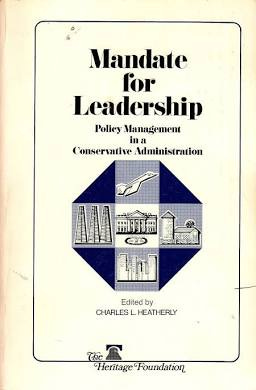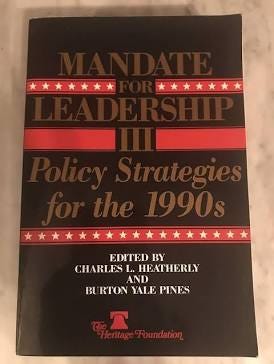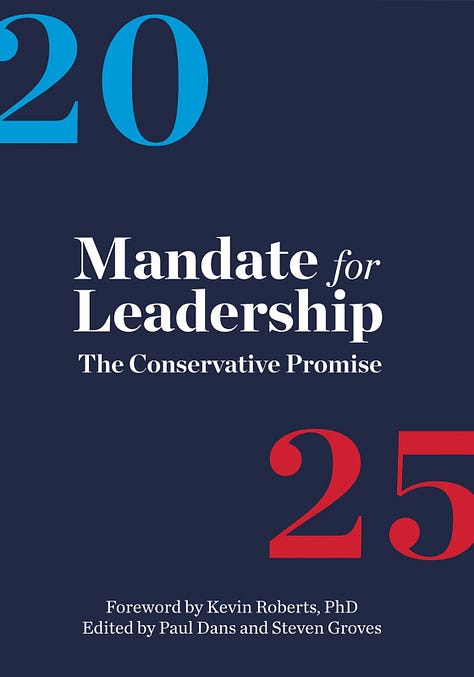Project 2025 and the Religious Right: 1920s-Reagan
For those just getting their feet wet in the wide waters of the Religious Right and Project 2025.
This essay seeks to explain the rise of the Religious Right through the 1920s. Please subscribe below to receive the next posts about the Religious Right and its involvement in the 1960s, with the Reagan administration, post-Reagan, and our current Trump administration. You can view my sources at the end of the post.
We have to get one thing out of the way: Project 2025 is the nickname of the document titled “Mandate for Leadership”, authored by the Religious Right coalition made up of over 100 organizations and groups and spearheaded by the Heritage Foundation. The “Mandate for Leadership” has been revised and updated since the Reagan years for each presidential cycle. There have been many versions, sometimes called “Project XXXX (Year)”. You can read the 2025 document in its 900 pages here.



The “Mandate for Leadership” is a collection of fiscally and socially conservative policies and is authored by folks with Ph.Ds, high-ranking titles, and religious backgrounds. The 2025 document covers everything from the reorganization of government departments and hierarchy, to cutting fiscal spending, to privatization policies of the Veterans Affairs and the Department of Defense, to immigration and tariff policies, to doing away with gender, race, and sexuality terminology and departments and criminalizing transgender folks and supporters. It is easy to read and is designed to be accessible by the masses for easy consumption and adoption by assenters.
But when did the Religious Right become so powerful? We have to walk it back to the 1800s and early 1900s.
In the 1800s, evangelism was prominently focused on social reform. Issues like temperance and narcotics, malnutrition and health, abolition, women’s rights, and Native American sentiment gave way to church congregations taking a firm stand in creating a society that modeled that of Jesus’s teachings. They believed in a theological framework called postmillennialism that claimed Jesus would return after the year 2000 (the millennium), and believers sought to ensure society looked like what Jesus had commanded His followers to build. However, this postmillennialist belief was challenged by several high-status pastors, including John Nelson Darby, who said that Jesus could come at any time.
This sent some of the postmillennialist evangelicals into a tizzy: if Jesus could come at any time, and the world is still “broken”, why bother with saving the world? Why not worry about ensuring our own souls and our loved one’s souls are saved and we are living a pious life?
This new framework is called ‘premillennialism’, and thus, they turned inward. They left the cities and urban areas and started communities in rural areas. Conservative seminaries seemingly in the middle of nowhere are evidence of this.
They were kind of isolated, doing their own thing through the early 1900s, but by 1925, the battle between the government and Christianity was rekindled. The South had been especially disgruntled since the government prohibited slavery, an institution southern pastors and believers argued was justified by the Bible. But now, in Tennessee public schools, these isolated Christians wanted to teach Creationism. This got them all wound up in the courts in the 1925 Scopes Trial that essentially pit Evolution and Creationism against one another.
So, now the Christians are feeling attacked by the government because they can’t teach religious origin myths to children in taxpayer-funded schools.
They resolve to bury themselves further underground. At one point, conservative Christians, especially far-right, were the least registered to vote group of the white demographics before the Voting Rights Act of 1965.
They look with dismay at the Civil Rights movement, with its free love, anti-Vietnam, pro-people of color, women’s rights advocacy. They groan at the thought of these hippies holding hands and dancing and smoking cigarettes and listening to The Beatles. Those heretics! Those godless, lost souls!! God forbid Janis Joplin is on the radio. Jimi Hendrix is a pop culture icon? LORD HAVE MERCY.
Following the Brown vs Board of Education case of 1954 that desegregated schools, a Christian university, Bob Jones College in Greenville, South Carolina brought desegregation and tax-exemption status into the debate. The administration down at Bob Jones didn’t like the fact that they were forced to accept people of color into their private Christian school, and the IRS didn’t like how they were expecting tax-exempt status while continuing the practice of discrimination. This landed everybody in the courts for the 1970 Green vs Connally case, in which the courts and IRS held up that discrimination prevents private schools from tax-exemption status or tax-deductible charitable donations.
So now, the government is telling the Christians what they can and cannot teach in public schools, and who they can and cannot enroll into their private universities. “An outrage!” They said. “The government is attacking Christianity!”
God forbid Christianity is inclusive of all people. God forbid a government founded on the separation of church and state implements a ban of religious education in taxpayer schools.
So now they start organizing. Now, they figure, the government is out to get them, and this secular hippie American culture is dancin’ with the devil. The whole world has lost their way, and it is up to Jerry Falwell and the Religious Right to bring God back into American society and save this country before it further travels down the levels of Dante’s Inferno.
But how?
In the first year of Nixon’s administration, a team of Republicans within the world of Nixon said, “I wish we had a conservative game plan to hit the ground running.” And a coalition of conservatives began creating one.
The conservatives and Religious Right started to expand their messaging. While desegregation and religious instruction in schools sparked the flame, they needed to grow their movement. They looked to homosexuality initially, but queer pop culture icons were making it hard for them to go on the attack as their next mission. So they targeted fringe communities who opposed Roe v Wade. Nevermind the fact that Southern Baptists, Episcopalians, Methodists, and other mainline Protestants already made public statements supporting Roe v Wade, the Religious Right aimed to target Christians who didn’t like ‘baby-killing’. They helped them develop pamphlets and messaging, and by the late 1970s, abortion was a hot topic.
The 1970s were also a time for environmental regulations on big industries in coal, oil, and mining. Who else could join the conservative movement and bring in an injunction of cash? Who else didn’t like people of color? Wealthy oil men in Texas and Appalachian coal company leaders. Whether these rich white men were Christian (which they most likely were) or were Republican (most likely were), the Religious Right had a natural ally with energy and fuel companies towards hating government regulations. Garnish the pot with racist and sexist language, and the Religious Right now had oil, gas, coal and mining money as part of their movement.
The conservatives took a hit with the surprise rise and election of Democrat Jimmy Carter, a Southern Baptist Georgia boy who taught Sunday School and seemed like a breath of fresh air to the voters following the Watergate Scandal. When Carter sided with the courts on the Bob Jones case and doubled down on blocking prayer in schools, the Moral Majority, led by Jerry Falwell & Friends called Carter ‘amoral’ and began working against him. Through slanderous attacks from the right, Carter learned pretty quickly he would be a one-term president.
Because who was on the horizon? The charming, charismatic movie star governor over in California who was more than willing to read a script for a little bit of fame. The Moral Majority and their Republican friends had developed the Mandate for Leadership, a 3000 page document instructing the next Republican president on how to lead a nation. They wrote the script, they just needed a little bit of star power.
Join me next time as I dive into the rise of Ronald Reagan.
Butler, Jon, Grant Wacker, and Randall Balmer. Religion in American Life: A Short History, Second Edition. Oxford and New York: Oxford University Press, 2011.
Balmer, Randall. Bad Faith: Race and the Rise of the Religious Right. Grand Rapids, MI: William B. Eerdmans Publishing Company, 2021.
White, Ellen G. Stimulants and Narcotics. Teaching American History.
Beecher, Catherine. An Address on Female Suffrage. Teaching American History.
Grimké, Angelina. “Appeal to Christian Women of the South”. The American Yawp Reader.



